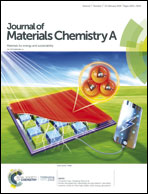Self-sacrificial templated synthesis of a three-dimensional hierarchical macroporous honeycomb-like ZnO/ZnCo2O4 hybrid for carbon monoxide sensing†
Abstract
This work reports the fabrication of a three-dimensional (3D) zinc oxide/zinc cobaltite (ZnO/ZnCo2O4) hybrid with a hierarchical macroporous honeycomb-like structure using highly uniform cobalt glycerate spheres as a self-sacrificial template. In the proposed method, the conversion of the template cobalt glycerate nanospheres into a 3D hierarchical macroporous honeycomb-like ZnO/ZnCo2O4 hybrid is achieved via a facile room-temperature reaction with aqueous zinc nitrate solution, followed by calcination in air at 350 °C. The proposed method offers several benefits including (i) the attainment of the ZnO/ZnCo2O4 hybrid in one step without additional or separate coating steps, (ii) the achievement of a unique 3D hierarchical macroporous honeycomb-like structure with interconnecting nanosheets and macropores which are assembled from smaller mesopores, leading to higher surface area and good interparticle separation, (iii) the relatively low calcination temperature required to obtain the ZnO/ZnCo2O4 hybrid (350 °C) and (iv) potential generalization for the creation of other macroporous honeycomb-like cobalt-based oxide nanostructures (including Al–Co and Cu–Co systems). When evaluated as a sensing material for carbon monoxide (CO), the hierarchical honeycomb-like ZnO/ZnCo2O4 hybrid sensor displays a higher sensing response with enhanced selectivity and stability towards CO gas at 300 °C compared to both ZnO hierarchical spheres and ZnCo2O4 nanospheres. The enhanced sensing performance of the hierarchical honeycomb-like ZnO/ZnCo2O4 hybrid is derived from the synergistic cooperation of the formed p–n heterojunction, large surface area and hierarchical macroporous nature of the as-synthesized ZnO/ZnCo2O4 hybrid. It is expected that the proposed general method may open a new path for creating other hierarchical macroporous honeycomb-like oxide nanostructures with enhanced surface areas and improved functional performance.



 Please wait while we load your content...
Please wait while we load your content...